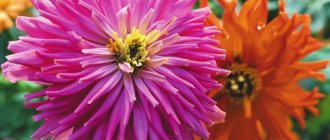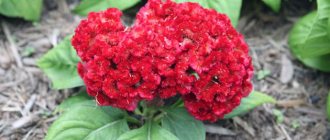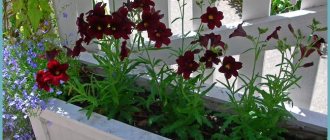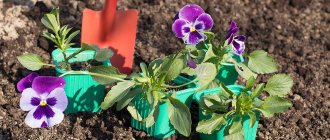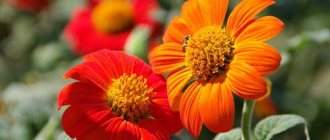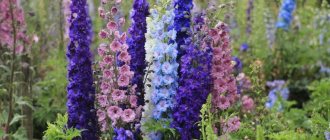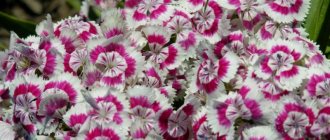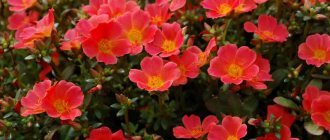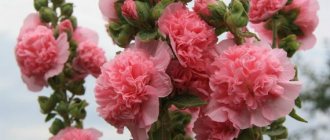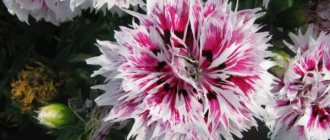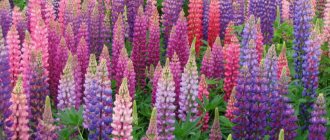Alyssum is an ideal plant for decorative lawns, borders and walls, and all because it has a very low growth - about 20 cm. It can undoubtedly be called the most popular of ground cover plants. In addition, alyssum pleases its owners with beautiful flowering throughout the summer.
Alyssum is an ornamental plant with a honey aroma. Other names for alyssum are lobularia, bargeweed, stoneweed, lawnwort
Popular types and varieties
All types of Alyssum are divided into:
- Annuals. The most popular, as they allow you to frequently change landscape compositions.
- Perennials. Among these species you can find very short ones - 8 cm, and subshrubs reaching 80 cm in height.
Decorative floriculture gives preference to 6 types of Alyssum.
Alyssum Rocky
A perennial herbaceous, densely branched plant no more than 20-25 cm high. The plant forms compact and very beautiful yellow spherical bushes. Rocky alyssum blooms at the end of spring. Flowering lasts about 1-1.5 months. Quite often it blooms again in August. The plant is considered unpretentious. Minimal care is required, which does not take much time from gardeners.
Rock Alyssum is represented by varieties:
- Golden wave. Flowering begins at the 2nd year of life.
- Compactum. A very fragrant plant, up to 18 cm high.
- Plenum. The inflorescences are yellow, double, and grow up to 30 cm.
Alyssum Gmelina
It is considered the shortest frost-resistant species among perennials. The height of the flower stems reaches 15-20 cm. Pubescent gray-green foliage covers the creeping stems. The dense yellow inflorescences often bloom as early as April, emitting a strong honey aroma.
Alyssum marine
Although this species is a perennial, in temperate areas it is cultivated as an annual. Lush bushes with silvery, oval, slightly pubescent leaves bloom from April to September. The color of the petals depends on the variety; it can be white or light purple.
The most common varieties among flower growers:
- Violet Konigin has bright purple flowers and grows up to 15 cm.
- Tiny Tim is very low, only 8 cm, and is distinguished by abundant snow-white flowering.
- Princesses in Purple are grown in hanging flowerpots. Long, almost half a meter shoots are strewn with light lilac fragrant flowers.
Alyssum ampelous
It is considered the most decorative species. Its highly branching long shoots look great in hanging containers. In them he looks like a huge flowering ball.
Common varieties:
- Crystal White Wave is a compact plant, up to 25 cm high, forming a continuous flowering ball. The vines are large with white fragrant inflorescences and reach a length of 35 cm.
- Esther Bonnet Pastel. The plant is highly branched, forms shoots up to 25 cm long. The flowers are small in pastel colors.
Snowy alyssum
This species is also called a snow carpet, since miniature alyssum, emitting a strong honey aroma, covers the soil with a snow-white carpet. It blooms for quite a long time: July-October.
Botanical description
Alyssum is a low-growing, groundcover plant, reaching a height of 15 to 40 cm. On highly branching, semi-lignified shoots at the base, there are small, pubescent, oblong or obovate leaves. The flowers are small, white, yellow, lilac, pink, red or purple, collected in small clusters, bloom in May and fade in late autumn. The fruit is a pod with seeds that remain viable for up to three years. Alyssum is a honey plant that attracts bees with its spicy honey aroma.
- Names and photos of asparagus
Strictly speaking, lobularia marine and alyssum are not the same plant, but they are close relatives and are so similar that gardeners, for simplicity, combine them into one genus.
The difference is simply determined: alyssum has fawn or yellow flowers, while lobularia has white, lilac or pink flowers.
Both perennial alyssum and annual alyssum are grown in culture. The plant is used for growing in borders, flower beds and flowerpots. It is often planted to camouflage places that are empty after the spring bulbs have faded.
When to plant alyssum for seedlings
More than half of flower growers prefer the seedling method of growing Alyssum. With this method, you can be guaranteed to plant the required area without fear that some seeds will not germinate and bald spots will form among the plantings.
Since Alyssum is quite cold-resistant, its seedlings can be planted in late spring. Thus, seeds are sown to obtain seedlings at the end of March, but flower growers still sow from mid-April.
The flower grows quickly, developed bushes are ready for planting within a month. But, nevertheless, when preparing for sowing, two factors should be taken into account: growing conditions and climatic features of the region.
In the northern regions, you should not prepare seedlings too early, as by the time of planting they will have outgrown and may become very sick. For pot growing, the time of sowing does not matter. One more important nuance should be taken into account - lighting.
Lack of light will lead to the stretching of Alyssum seedlings, it will be frail and painful. For early plantings, it is necessary to artificially extend daylight hours.
Growing alyssum from seeds at home
Alyssum seed material has good germination and does not require special preparation before sowing. You can buy seeds in stores or collect them yourself.
Preparing the soil and container
For small Alyssum seeds, choose wide containers. They can have different cells: large and small. The containers are pre-treated with a manganese solution. Several holes are made at the bottom to prevent water accumulation.
The soil will need to be loose and light. You can purchase a special substrate for flower seedlings at retail outlets.
Experienced gardeners prefer their own soil. To do this, mix garden soil with sand, add peat and season it all with humus.
To speed up the process of seed germination, the soil mixture is watered with hot water.
How to sow correctly
Alyssum seeds do not need to be pre-soaked before sowing. Their germination rate is excellent, and besides, it is quite difficult to sow a miniature caliber when it begins to hatch - the risk of damaging the sprouts is too great. The seeds are simply rarely scattered.
- The soil is prepared in advance, leveled, and slightly moistened so that the seeds have better adhesion.
- Small seeds are placed less frequently, trying to maintain a distance of 10 cm.
- In the sowing field, the seeds are lightly pressed into the soil, but they are not sprinkled on top: they must germinate in natural light.
- The top of the container is covered with glass and transparent film.
With sufficient moisture and light, the first shoots should be expected within a week.
If excessive thickening is observed, then the crops must be thinned out so that they do not become sick. The optimal distance between bushes should be approximately 20 centimeters.
How to sow alyssum - video
Seedling care
When the sprouts have just appeared, they need minimal care - very careful loosening, removing weeds with tweezers. Excess greenery should be observed and eliminated daily.
For young Alyssum seedlings, the most suitable temperature is +10…+15°C. Periodic ventilation and moderate moisture are also required.
When a seedling produces 2-3 leaves, it is usually picked out of a common container. However, this procedure is not mandatory, since at this age the seedlings are most often transplanted to a permanent place.
There are times when, even with proper care, Alyssum stretches out. Then the main shoot is immediately pinched: a third or even half of the stem is removed. After the procedure, the flower begins to bush, forming side shoots more intensively.
Methods for propagating lobularia
Methods of seed and vegetative propagation of alyssum allow you to choose suitable methods depending on the conditions available to the grower. If it is possible to provide additional illumination in January and February, then it makes sense to sow alyssum seeds for seedlings in January - according to the archery calendar, favorable days in 2021 will be the 10th, 15th and 16th.
If it is not possible to grow alyssum seedlings from seeds at home, then sowing can be done in unheated greenhouses. In 2021, the optimal time for this is from April 7 to April 11.
For those who did not have time to do this, we can advise sowing directly into open ground from May 10 to May 15. Well, there remains the possibility of winter sowing at the end of October.
Other methods of vegetative propagation include cuttings. It is advisable to preserve the mother plants at the end of the season. To do this, the bushes need to be brought into a heated room and trimmed short. In mid-December, it is necessary to increase fertilizing to increase vegetative green mass. Cuttings can begin at the end of January. Rooting occurs quickly, usually under plastic film.
In open ground, lobularia can be propagated by dividing the bush. The procedure is recommended to be carried out in the spring months (April-May).
Dates for sowing alyssum for seedlings according to the lunar calendar | ||
| Favorable time | Unfavorable time | |
| January | 10, 15, 16 | 5, 6, 12, 21 |
| February | 6-8, 12, 13, 18 | 3, 4, 20 |
| March | 14 and 16 | 3, 5, 31 |
| April | from 7 to 11, 16 and 18 | 5 |
| October | from 27 to 30 | 14-27 |
When to plant alyssum in open ground
Like any seedlings, Alyssum is planted when it has grown sufficiently and become stronger.
Pre-prepare the soil by checking it for moisture: if there is a threat of constant excess moisture, it is provided with drainage. The soil is also diluted with sand or other coarse bulk material. With good drainage, Alyssum also grows in partial shade. Excess moisture leads to rotting of the roots of the flower, and it dies.
Plant replanting is carried out in May-June. At this point, the seedling has acquired several pairs of full leaves. Another point that is taken into account when planting a flower is spring frosts. Young seedlings should not be exposed to low temperatures when they have just been transplanted and have not yet matured.
When preparing a place for the plant, you should take into account that it grows in breadth, so it is better to maintain a distance of 0.5 meters between the bushes.
The holes are prepared to be spacious enough to place the seedling along with a lump of earth. After planting, Alyssum is well watered.
Features of Alyssum
The bushes of the plant have a small height - no more than 20–30 cm. The flowers appear immediately in large quantities, are small in size (their diameter does not exceed 0.5 cm), and come in a variety of shades: white, pink, red, purple, yellow. Typically, Alyssums are grown in summer cottages, in private households, and they are even planted in city flower beds. The peculiarity is a strong sweet smell, which is better felt in hot sunny weather.
Many plant varieties, if properly cared for, can bloom from June until October. They are able to withstand frosts down to minus 10° C. Some species may not shed their leaves all winter.
How to properly care for alyssum in summer
To preserve the beauty of the flower, gardeners regularly water and feed it.
Top dressing
5 weeks after transplanting the crop, it must be fed with nitrogen and potassium fertilizers. By the time the buds open, you should take care of the nutritional content of the soil. It is saturated with a solution of Agricola-7 mixed with urea.
Annuals are fed 4 times per season, with the first 2 being carried out before flowering. Fertilize flowers with complex additives.
Watering
Watering Alyssum is completely excluded if the following conditions are met:
- Precipitation levels are above average;
- Adequate nutrition;
- Fertile soil.
Watering Alyssum should be abundant and frequent in permeable, light soil. The degree of humidity can be determined experimentally: if the soil is dry at a depth of 4 cm, then watering is required.
Often, gardeners mulch immediately after transplanting to reduce watering. This event does not replace regular loosening.
How to prolong flowering
It is very pleasant to enjoy the beauty of Alyssum all summer and inhale its intoxicating aroma. And it’s a pity that the flowering will soon stop. It can be extended by watering.
Alyssum is a fairly drought-resistant flower, but lack of moisture shortens the flowering period, therefore, for a longer growing season, regular watering is needed.
You should also take into account the tastes of the flower, and plant it in loose soils of moderate humidity. Moreover, the places should be warm, open, well lit. It should not contain many nutrients.
With a lack of light, the flowering cushion will become less dense. When oversaturated with fertilizers, the flower begins to increase its green mass, sometimes ignoring flowering completely.
The culture requires high-quality loosening and weeding. After the first wave of flowering, the plant should be cut back a few centimeters to stimulate the growth of new flowering shoots.
Growing alyssum from seeds in open ground
Spring sowing
First of all, soil preparation for sowing alyssum should begin with improving its drainage properties. In the places of proposed planting, holes are dug and pebbles, sand, and expanded clay are placed in them.
Then be sure to add compost or humus. Liming is mandatory for acidic soils, since alyssum categorically does not tolerate them. The soil is dug up and leveled. Some gardeners even recommend pouring manganese boiling water over it.
In April, Alyssum seeds are scattered onto a slightly moistened prepared area. The emerging seedlings are watered moderately. When the seedlings grow, they are thinned out and planted. Such a plant will bloom by July - 2 months after sowing.
Sowing before winter
Sometimes Alyssum is sowed in a canopy. A flower that has survived the winter cold sprouts early and blooms much earlier.
However, there is a considerable risk of freezing of the planting material due to its shallow planting.
To carry out successful pre-winter sowing of crops, you need to take into account the following factors:
- Average temperature in winter;
- Duration of cold weather in a given area.
Experienced flower growers always sow seeds in November, and they undergo natural stratification. The procedure is carried out directly on the soil, which has not yet completely cooled down after the summer heat. If the weather is warm at this time, the possibility of seedlings appearing, which will need to be properly covered for the winter, cannot be ruled out.
Other supporters of pre-winter sowing scatter seeds on frozen soil when the temperature is stable, close to zero. In this case, seed germination is excluded, they overwinter safely under the snow, and in the spring they sprout vigorously.
Typically, in mid-latitudes, sowing is carried out at the end of October, and in the southern regions - even at the beginning of December. If the weather is warm, then you should not rush into pre-winter sowing, since seedlings will definitely appear, but will die when frost sets in.
Pre-winter sowing of flowers has many advantages:
- Natural growing conditions are created under which the seeds undergo vernalization and produce strong seedlings;
- Unstable spring weather makes it difficult to choose the optimal moment for sowing, and winter plantings can unmistakably choose it themselves;
- There are places where the soil remains cold for quite a long time. All negative factors for spring plantings do not affect autumn plantings;
- Pre-winter sowing eliminates the hassle of growing seedlings and crowded window sills. In addition, the necessary stratification is carried out by nature itself;
- Natural selection is carried out independently among the seeds. Only the strongest germinate, and they are distinguished by their resistance to disease and unexpected cold;
- Plants sown in autumn have a more developed, tap root system. It penetrates deeply into the soil, extracting moisture. Thus, Alyssum requires less watering and becomes more drought-resistant.
And yet, pre-winter sowing, for all its advantages, is not without its disadvantages:
- Winter thaws can trigger the awakening of seeds, and subsequent frosts will destroy them;
- Prolonged waterlogging can kill seeds;
- The germination rate of seeds is much lower, since the conditions set before them are too harsh.
Aftercare rules
While the flower grains are developing and growing, they are under a covering material (food film or polyethylene). But 7-10 days after pipping, it is removed.
To prevent the seedling from immediately freezing, hardening should be carried out daily. Follow the rules for caring for alyssum, which are not complicated.
Loosening
Until the seedling is transferred to open ground, the loosening process is carried out using a stick. Do only when necessary so as not to damage the delicate root system.
The procedure may be required if the plant was not planted in a store-bought substrate.
Watering
Alyssum does not tolerate waterlogging. Hence the rule that must not be forgotten: moisten the soil as necessary. At the initial stage, every other day. Then check the soil regularly to ensure that new watering is necessary.
Weed removal
To avoid the need to additionally remove weeds, which can only appear in independently prepared soil for planting, you should choose a store-bought substrate.
Before planting seedlings, homemade preparations are processed:
- remove plant debris;
- add the necessary ingredients;
- steamed with boiling water or fried in the oven.
Temperature and light conditions
Despite the fact that alyssum is a frost-resistant plant, the flower loves a lot of light and warmth. Therefore, plan to plant in an area that will get plenty of sun. After planting the seed, the containers are placed under lamps for additional lighting.
Temperature for germination: 15-18 degrees.
Picking
Picking is carried out only after the appearance of real leaves that will hold tightly to the stem. It is at this moment that you should feed the flower. This will help quickly relieve stress from the seedling. Picking requires preparing “separate houses” for alyssum in advance.
Topping
Pinching the crop can only be done if the sprout has become very elongated. But this is rare, which allows us to confidently say: the procedure is not necessary in caring for alyssum.
Protection from diseases and pests
The flower crop belongs to the cruciferous (brassica) family. That’s why pests settle on it, loving to “chew” cabbage. These are caterpillars, flea beetles, whiteweeds, and cabbageweeds.
Slugs and snails can also encroach on the beauty, but with proper insect prevention they will not become a threat.
Caterpillars
It is best to use chemicals that will remove not only caterpillars, but also other insects. Suitable: Fitoverm and Actellik.
Cruciferous flea beetles
Folk recipes will help save flowers from fleas. Namely, an infusion of wormwood, garlic or tobacco dust.
White butterflies
It is best not to look for one drug that will help remove butterflies. Use comprehensive protective equipment, of which there are many in stores.
Cabbage moth
To avoid problems with the appearance of cabbage, alyssums are sprayed with Actellik solution in advance. The product protects against most insects.
How and when to collect your seeds
Alyssum seeds are very small and difficult to collect. However, if you follow the recommendations, the collection will be successful:
- The best time to collect seeds is the end of September.
- A windless day is needed so that the seeds do not scatter, and dry.
- The lashes of the flower are carefully lifted, and a cloth or film is spread under them.
- The inflorescences are rubbed by hand, all the contents are poured onto the substrate.
- The entire resulting mixture is dried, sifted to separate the seeds from the husk, and placed in a canvas bag.
Collecting seeds for planting
To grow alissum seedlings, it is advisable to collect your own planting material. At the end of flowering, the Snow Carpet forms small seeds at the ends of the shoots. Collecting them is not as easy as it seems.
For work, choose a windless day at the end of September. An old cloth is spread under the bushes and the inflorescences are thoroughly rubbed with your hand to release the seeds. During work, large debris may fall off; it must be taken away immediately.
The finished seeds are dried and packaged for further storage in paper bags with the name of the variety. Germination persists for three years, but fresh seeds germinate faster.
Important! Alyssum Snow Carpet reproduces well by self-sowing, but this should not be allowed, otherwise the flower will quickly fill the entire space.
Problems during cultivation
To exclude possible diseases of Alyssum, you do not need to neglect the rules of planting and care. In the absence of fertilizing, excessive humidity, and sanitary pruning, various diseases may appear:
- The most common problem is late blight. The soil, saturated with moisture, begins to turn sour and infects the root collar of the flower. To get rid of brown rot, the soil is treated with fungicides Kuproksat, Ordan. Watering is not carried out for some time.
- Another problem that affects the crop is powdery mildew. It appears after excessive pruning, after overfeeding Alyssum with nitrogen fertilizers. Powdery mildew can also be triggered by sudden temperature changes. When the disease appears, use the fungicide Fundazol or Bordeaux mixture.
- Alyssum is a cruciferous plant, so it is often affected by the cabbage flea beetle. To get rid of the pest, appropriate chemicals are used.
- You can often see caterpillars on the plant. You can drive them away with tobacco infusion.
- Spray Alyssum with bacterial agents Lepidocide, Kinmiks to get rid of cabbage moths and whites.
Diseases and pests
Alyssum is a cruciferous plant. It also includes cabbage and radishes. Therefore, alyssum can be damaged by pests of these plants. This:
- The cruciferous flea beetle can significantly spoil the appearance of the flower “carpet”. You can fight it by treating adult plants with a solution of vinegar essence. You can use insecticides before flowering. During flowering, bees and other beneficial insects flock to the sweet smell of alyssum. Therefore, it is not worth treating with chemicals at this time. The flea beetle stops harming the plant when it grows.
- White butterflies and their caterpillars are destroyed with lepidocide and other insecticides.
- When growing alyssum in shaded areas or when the area is dense, the plants may be affected by powdery mildew. It is manifested by yellowing and falling leaves. You can fight it using fungicides. Infected parts of plants are burned, and the remaining parts are treated with a soap solution with colloidal sulfur.
- Sometimes alyssum is affected by white rust or brown rot. These are dangerous diseases that can lead to the death of many plants. Therefore, the affected plants are removed from the flower garden and burned.
What flowers are combined with alyssum in the flowerbed?
Alyssum's popularity increases due to his sociability. It looks great in a variety of compositions. In flower beds, the crop is planted in the company of many perennials and annuals. Even ground cover and hanging plants go well with it.
The flower is planted in mixborders, rockeries, and Alyssum is often found in alpine hills. Luxurious bouquets are made from tall varieties, combining them with tulips, irises, and roses.
The plant is planted on stone slabs, on dry slopes. A very unusual contrast is provided by purple Alyssum with pink phlox or dwarf irises. Alyssum and muscari will create a bright composition.
A good combination of Alyssum will be in compositions with heliotrope, Turkish carnation, and pelargonium. Often the culture acts as a background plant, ideally emphasizing forget-me-nots, lilies, aubrieta, rezuha, and purslane.
Purple Alyssum harmonizes with silver cineraria and golden marigolds. White varieties look luxurious together with salvia, begonia, and petunia.
Using Alyssum “Snow Carpet”
Alyssum is planted in rockeries, where it feels good next to large stones. Mixborders and borders are placed in the foreground. In flower beds it serves as a background for large-flowered plants. It covers places in landscape compositions where faded bulbous plants are located.
Alyssum is also grown in hanging pots, containers, and flowerpots.
With their help you can decorate your balcony or terrace. The best neighbors will be forget-me-nots and viola, which are grown with alyssum in the same container. The aroma of alyssum “Snow Carpet”, planted on the balcony, will penetrate the room and improve sleep.
Looks great on alpine slides. Alyssum fills any spaces, even between stones or tiles. The best neighbors for alyssum are dwarf irises, marigolds, phlox, carnations, and lobelia. In spring it goes well with muscari and late tulips.
More information can be found in the video:
Source
